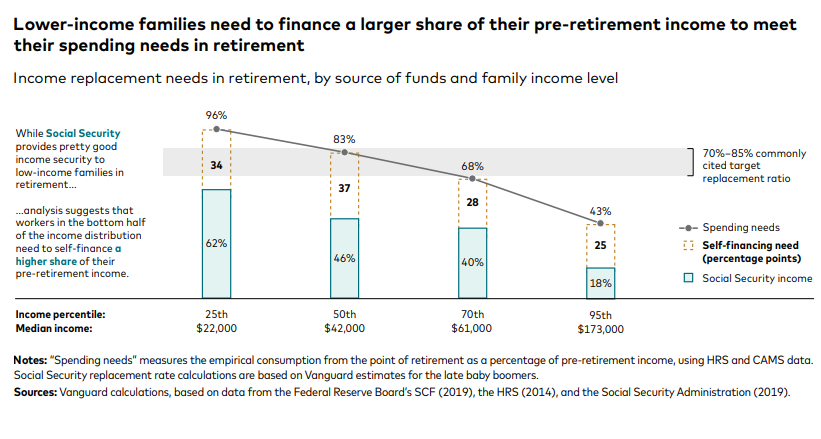You’ve Discovered You Have Retirement Income Gap, Now What?
8 Strategies You Can Use to Ensure a Financially Comfortable Retirement.

Retirement is a time to enjoy the fruits of your labor, but what if you find yourself without enough income to support the standard of living you pictured?
Your retirement income gap is the difference between the income needed to maintain a certain lifestyle and your expected income from current planned sources, such as pensions/retirement plans, social security and savings. This article outlines practical solutions you can implement to bridge the retirement income gap, ensuring a comfortable and secure future.
Most financial planning softwares (and therefore financial planners) will tell you that your main options in this situation are to either continue working longer and delay retirement, or to downgrade your standard of living expectations. There are however much better options I use with my clients to enable them to achieve their desired retirement. I’ll provide a high-level overview of each strategy here, providing more detail in future newsletters.
1. Ensure You Are Debt Free Well Before Retirement
Lucky for you I'm a certified Debt Free LifeTM consultant. The Debt Free Life proprietary software program uses data science technology to analyze all your debts and amortization schedules (including things like your mortgage, credit cards, auto and solar loans, student debt, personal loans and more) then combines them with traditional debt payoff methods such as the debt snowball and debt avalanche, plus the infinite banking concept to use your money twice: both paying off your debts and growing it tax free for retirement at the same time. You are basically creating your own bank and playing interest rate arbitrage so that the interest normally paid to your lenders goes into your pocket instead, plus it compounds to add to your retirement nest-egg. I’ve been able to help my clients pay off all their debts, including their mortgages, in on average 17 to 25 years less than planned. Given that mortgage payments can average somewhere between 20-30% of our monthly budget this can make a huge difference in closing your retirement income gap.
2. Pay Less For Your Children’s Education
The cost of college is an ever-increasing burden on students and their parents’ retirement alike. Here are just some of the changes which are conspiring to increase your child's cost to attend college.
- Over the last decade, the exclusion of traditional retirement accounts from the financial aid calculation has been gradually reduced, and last year it was removed entirely, meaning that all your retirement income is now up for grabs to pay for your child’s education.
- More recently at the end of 2021, right before handing over power, the GOP put in place legislation effective this year in 2023 to remove the fees discount for having multiple children from the same family in college at the same time.
- While there are still some financial assets exempt from reporting to the colleges, your financial position is now assessed 2 years prior to your student starting college, leaving most families to learn too late how to reallocate assets to pay what can be 10’s of 1000’s of dollars less for their child’s college education.
- Merit funding grants and awards take account of the classes and activities undertaken by your student right through their high school career. Again, most families start too late to make a significant difference in their children's cost of education.
My recommendation if you have a child – as soon as you have any inkling that they will attend college – that’s the time to get started. As a Certified Advanced College Planner I can help coach you through the process to ensure your child/ren is able to get into a better college for a much lower cost.
3. Reduce Your Current Health Insurance and Healthcare Costs
The current healthcare system is designed to make as much profit as possible for health insurance and pharmaceutical company executives and shareholders. If you keep yourself reasonably healthy though, there are now alternatives such as coop plans and shared health cost cooperatives that can save you up to 70% of the cost. Shopping around for health coverage on a regular basis is definitely good strategy. As a licensed insurance broker I can help you assess your current plan, plus shop around for you to see if something better is available. As a fiduciary, my obligation is to always put your interests first.
Additionally Quility Rx which is part of the
My Quility Savings App will help you shop around for prescription prices. Whether you have prescription cover included in your insurance or not, you can see significant savings by using Quility Rx inside the app to check prices at the different pharmacies near where you live or work. You will be surprised at how much the variance in pricing can be.
4. Outsource Your Future Healthcare Costs to Someone Else
The largest healthcare costs most of us will face in retirement are nursing home care, long term care or home health care costs. 72% of us are going to need at least one long term. Rather than take the $8,000-$12,000 per month for these costs out of your retirement income, other options include: long term care insurance, chronic care income riders within life insurance policies, and annuities which include income doublers in the event you are confined to a nursing home.
5. Significantly Reduce Your Risk by Taking Preventative Action
The three largest causes of healthcare costs in the US are cancer, heart disease and diabetes. The latest research shows that only about 8-12% of the causes of these 3 diseases are genetic while the remainder is based on nutrition, lifestyle and environmental factors. That means we have a huge amount of control over our future healthcare costs and can in the vast majority of cases prevent them from occurring. I’m a big believer in holistic and preventative healthcare using food as nutrition. I’ll provide more details on some of the latest research and my personal approach in a future newsletter.
6. Reduce Your Current and Future Daily Living Expenses
No I don’t mean giving up things that are important to you. We live in a very fast evolving time where technology is improving every second of every day. When was the last time you reviewed your expenses to see if you do in fact need all your current subscriptions, or to see whether there are less expensive and now better options available? Have you ever negotiated price discounts based on being a loyal customer? All of this is possible and more if you know where to look and how to do it. Plus there are now also services that can do the hard work for you. More details to come on your options here in a future newsletter, however a great place to start is understanding your current expenses and budget.
To get a head start, you can check out auto-pilot, which is a do it for you bill negotiation service. You upload copy of the bills you want to ave on, n their term of expert negotiators get to work. Not only will they save you money now, but they will also automatically follow up and try to negotiate an even better eal every 6 months. I find that even if they aren't able to get me n ongoing monthly savings that can till get one of credits to my account which put cash back in my pocket. Just this month they reached out for my regular 6 month negotiation review and were able to negotiate new deal on my and my husband's cell phone bill which is saving us $46 every month with the cost guaranteed not to go up for the next 36 months. I was pretty impressed. My negotiator was great, she communicated with me through the process to make sure that not only would I not lose any benefits I need now, but in actual fact they increased on the ones I do. If you want to
check it out for yourself, you can do so here.
7. Leverage Your Home Equity
Home equity can be an untapped source of retirement income. Consider downsizing to a smaller home or moving to a more affordable area (or even some exotic overseas location), which can free up cash for your retirement. Alternatively, look into a reverse mortgage, which allows you to borrow against your home equity, providing a steady income stream. HELOCs are another option depending on your situation.
8. Purchase Future Income At Reduced Rates Today
While I have always understood that an annuity will provide you with much more income over the long term than the same lump sum, I only learned the concept of buying future income through life insurance a couple of years after moving to the US from Australia in 2010. This is because Australia being a semi-socialist country does not allow cash value life insurance since they consider it to be tax evasion; and in order to pay for socialised medicine, education, community services etc, everyone must pay their share of taxes. It's this tax free growth status of the funds within the policy that make cash value life insurance policies (when set up correctly) like an annuity on steroids - with greater flexibility and more bonuses (providing you start investing when you are healthy and sufficient years before retirement).
If you keep an eye on financial news you would have noticed that annuities are coming back in style. While you have have heard stories about annuities in the past, thanks to increased regulation and guarantee requirements these now come with entry bonuses, long-term care doublers, and guaranteed lifetime income riders that are indexed to protect your income from inflation.
If any of these 8 strategies seem like they may be useful to you, feel free to reach out and schedule a call to discuss your personal situation.
In the meantime watch out for future newsletters where I’ll break down each one in more detail. Debt Free Life being first next in line.






